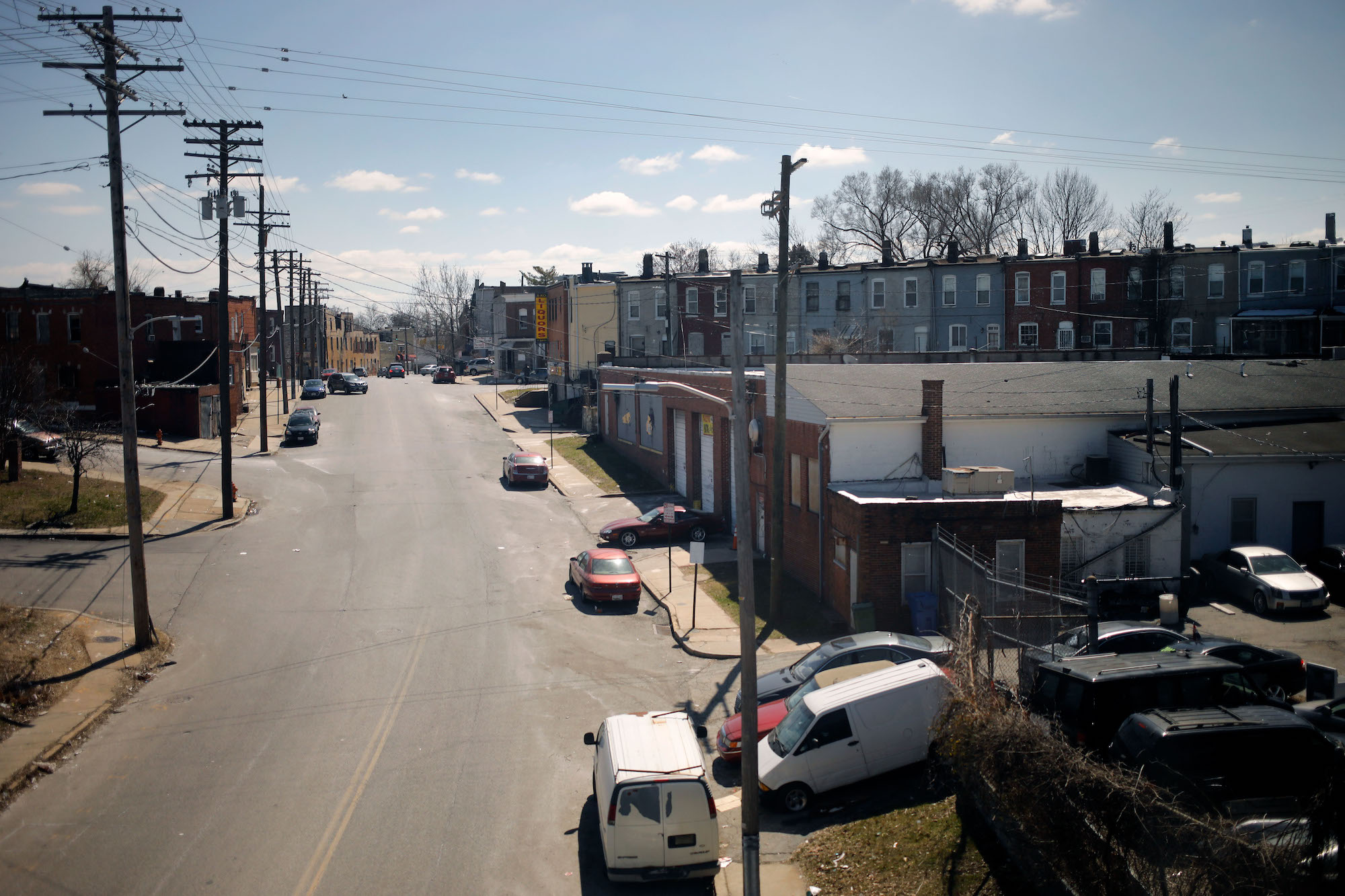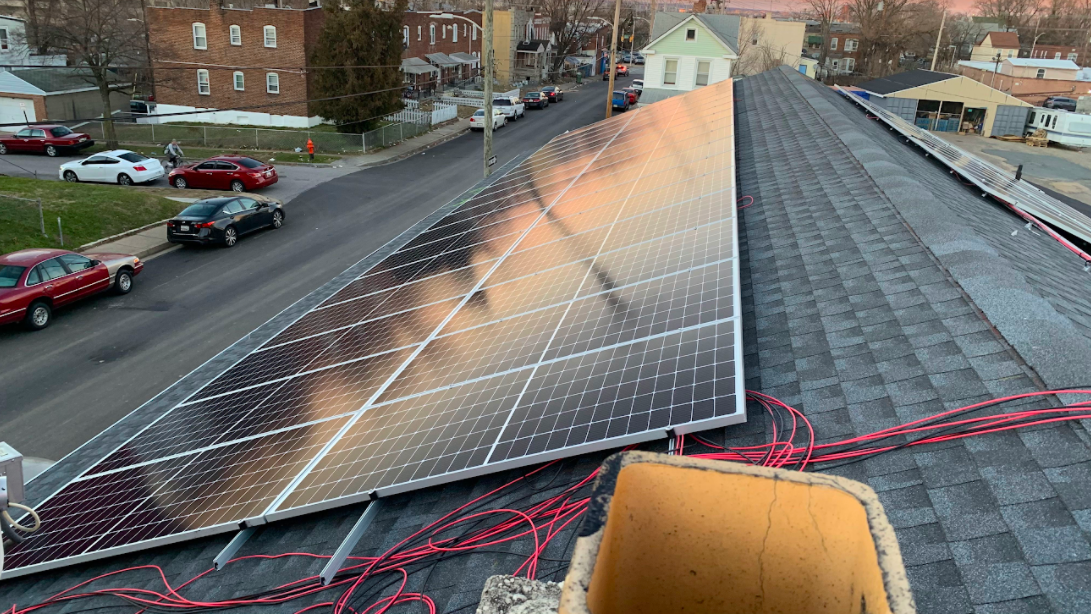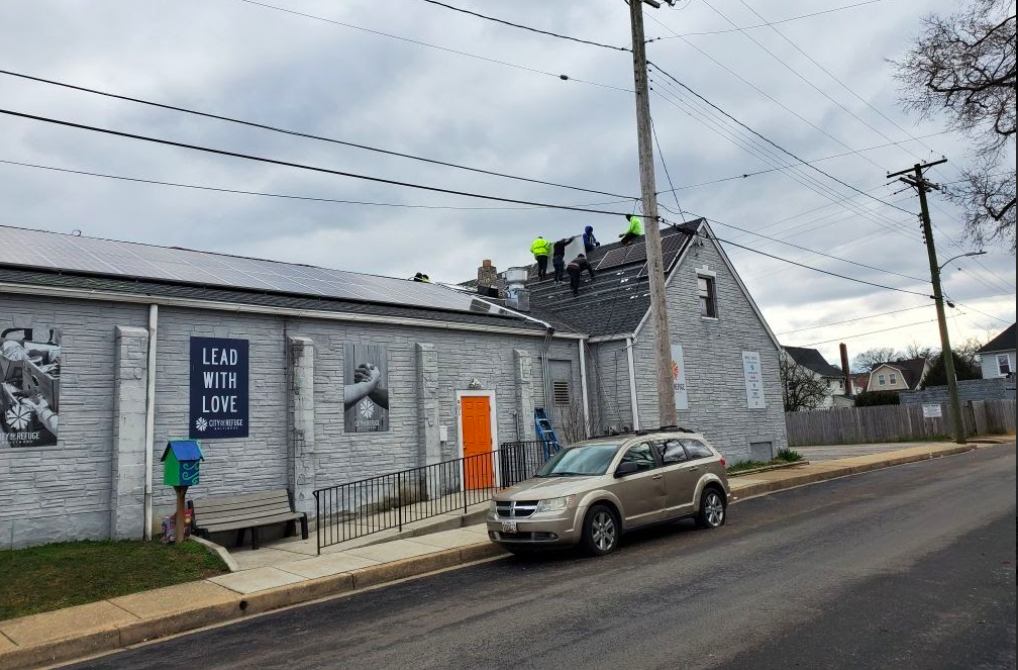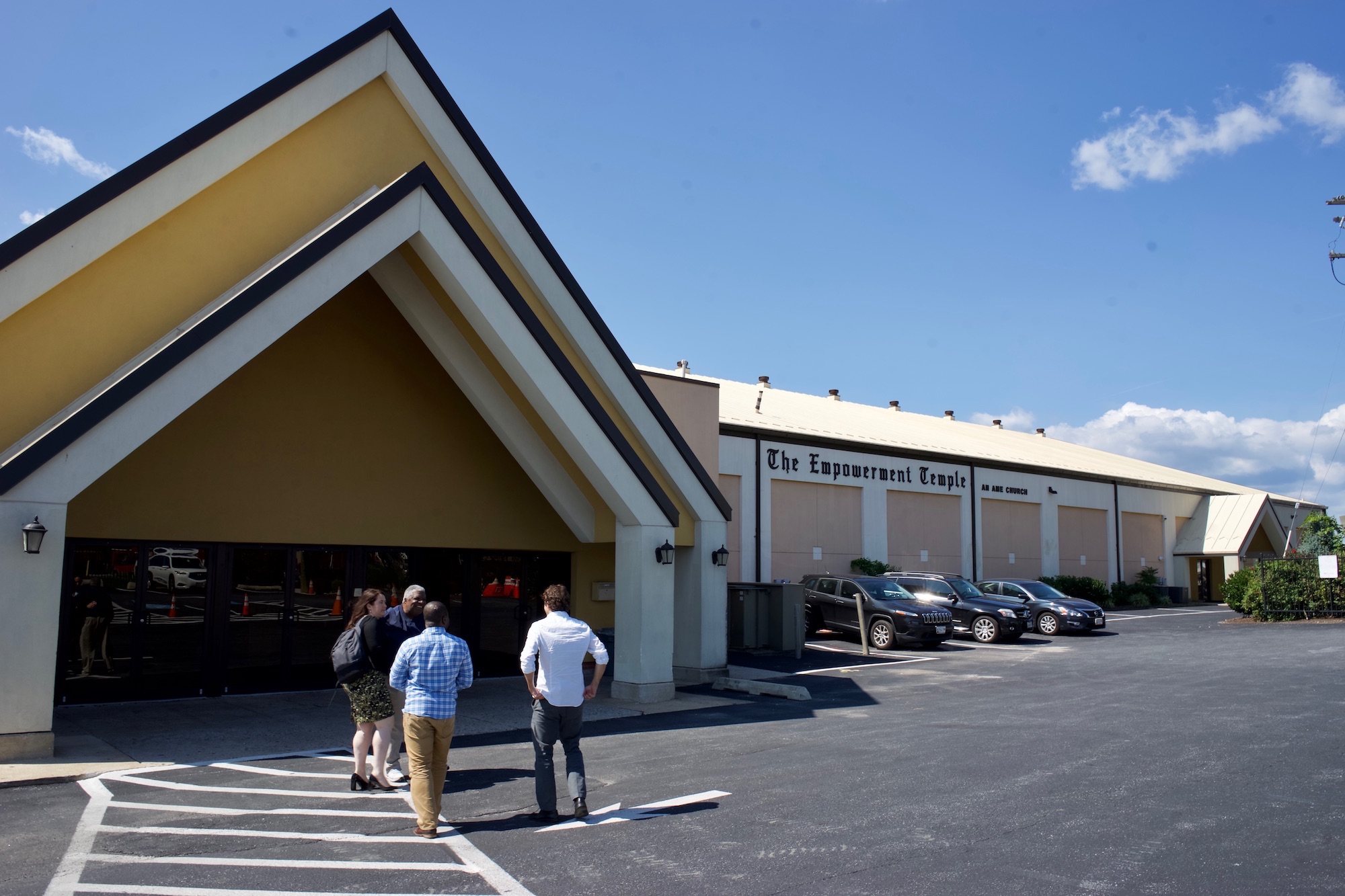Empowerment Temple, a predominantly Black megachurch in Baltimore’s Park Heights area, is a place neighbors can often go for free meals, school supplies, and drive-thru COVID-19 tests. Soon, they’ll also be able to visit the long, beige building to charge cell phones, refrigerate medications, and cool off (or warm up) during the next power outage.
City and state agencies are providing hundreds of thousands of dollars to equip the Maryland church and other facilities with solar panels and battery storage systems — creating “resiliency hubs” that serve vulnerable communities following extreme weather events or grid failures.
“A hallmark of our ministry is, ‘How can we help people in distressed situations?’” said Anthony Robinson, a church member and leader of the nonprofit Economic Empowerment Coalition, which is helping implement the clean energy project. “We see this as an opportunity to be of service to the broader community.”
Construction is set to start this month on a 120-kilowatt rooftop solar array, which will supply electricity to banks of batteries at the church. Should tornadoes and flash floods knock down the grid — as they did this month in Ida’s wake — the building will become a pocket of energy in the neighborhood, which is largely low-income. Like other Baltimore resiliency hubs, Empowerment Temple will be able to also use the systems to help lower their own electricity bills by selling excess solar power to the utility company and drawing from the batteries when grid power is expensive.
The church’s battery will have a capacity of nearly 500 kilowatt-hours, which is a measure of how much energy the system can store or discharge in an hour. (The average home in Maryland uses about 975 kilowatt-hours per month, according to 2019 data.) In practice, that battery capacity means Empowerment Temple can bank three days’ worth of backup power to keep lights and appliances running in a designated common area.
“Low- to moderate-income communities are normally the places where, when disasters hit, they have the least amount of resources,” said Lenwood Coleman, chief program officer at Groundswell, a nonprofit solar developer working with the City of Baltimore to plan and design the hubs. The partners are identifying up to 30 more sites that could host solar-plus-storage systems, along with solar installer Suncatch Energy and technology provider A.F. Mensah.
The initiative “allows us to look at churches and schools as a place where people can comfortably come during brownouts or blackouts to get support they would not normally get,” Coleman said.

Baltimore’s resiliency hubs are rolling out as solar-plus-storage takes off around the country. In recent years, the U.S. energy storage market has seen a more than 20-fold jump in annual growth, from 161 megawatt-hours of total new storage capacity in 2015 to an additional 3,700 megawatt-hours in 2020, according to the energy research and consultancy firm Wood Mackenzie. That includes utility-scale installations that absorb wind and solar power, as well as smaller systems in hospitals, industrial facilities, and single-family houses.
Residential storage alone — which in most cases means batteries paired with solar panels — is expected to see new project capacity nearly double in 2021 compared to last year’s total, said Chloe Holden, a Wood Mackenzie analyst. Falling costs and growing battery options are driving more people to install the technology. But Holden said “the main selling point” for battery storage is backup power. Without a battery system, most solar arrays will automatically shut off in the event of a grid-driven power outage. Major grid outages are becoming more frequent and longer-lasting as the nation’s aging infrastructure buckles beneath the barrage of climate-fueled weather events, an analysis by Climate Central found.
In the case of rooftop solar systems and electric vehicles, state and federal assistance programs have historically favored the “early adopters” with money or garage space to invest in emerging technologies. Community groups and policymakers in Maryland, California, Illinois, and other states are working to ensure that low-income residents are included from the start in energy storage programs.
“We need to make sure that the [storage] market develops in an equitable way as it expands,” said Michelle Moore, CEO of Groundswell. “That it’s not just resilience for those who can afford it.”

Power outages are common in Maryland, where extreme heat waves, severe flooding, and high winds regularly batter the grid. In Louisiana, outages caused by Hurricane Ida in late August are expected to persist for weeks. Earlier this year, more than 4 million customers in Texas lost power during a deadly winter storm.
“What people are now experiencing is a huge disruption all the time, and it’s all across the country,” said Vikram Aggarwal, CEO of EnergySage, an online marketplace for solar arrays and storage systems. He said the website’s traffic from Texas spiked in late February following the winter outages, and that a higher percentage of customers are searching for batteries today than they did before the storm.
In drought-stricken California, utilities have started to preemptively cut off power to prevent electrical equipment from sparking fires on hot, windy days. Last year, California’s utility regulator authorized funding of more than $1 billion through 2024 for the state’s Self-Generation Incentive Program. Known as SGIP, the program provides upfront rebates for installing energy storage systems. It’s also largely why the Golden State has more than 80 percent of the nation’s small-scale storage capacity.
Don Young, a homeowner in Northern California’s Marin County, said a nearly four-day-long power shutoff in 2019 prompted him to consider solar-plus-storage. His 4.8-kilowatt SunPower system can keep his lights and appliances running during brief power outages, of which he’s experienced two since installing the array in March. Young received a $2,000 rebate for the system, which cost north of $32,000. He said he expects to recover that sum in seven years by selling solar power and saving on utility bills.
Still, for many people, such a price tag remains prohibitively expensive. Larger systems, including those installed in Baltimore, can cost several hundred thousand dollars to build and maintain. To that end, California offers “equity resiliency” SGIP rebates that can nearly, if not completely, cover the cost of battery storage systems of homes or critical facilities. In Oregon, policymakers recently allocated $10 million to expand the state’s Solar + Storage Rebate program, which enables low- to moderate-income customers to receive up to 60 percent of the cost of a storage system; other customers can get up to 40 percent.
“Low-income individuals do not have the extra income to even finance a solar panel, so we cannot expect them to finance storage,” said Olivia Nedd, the policy director of Vote Solar’s access and equity program. She said state energy storage policies should include “carve-outs” — guarantees that disadvantaged communities receive a certain percentage of funds or total installations — and should invest in customer outreach and demonstration projects so that people in low-income neighborhoods learn how to access such opportunities. Without deliberate steps, Nedd said, solar-plus-storage programs are bound to bypass the people who might benefit most from having emergency power. That includes the medically vulnerable and those who can’t leave town when the grid goes dark for extended periods.
Not all solar equity programs focus on recruiting individuals. Some states have sought to expand participation through “community energy storage.” This typically refers to utility-owned projects that are designed to keep the lights on in areas that experience frequent service interruptions, particularly during extreme weather events.
In Illinois, the utility ComEd launched one of the country’s first CES pilot projects in 2017 in the village of Beecher. The company installed a 25-kilowatt-hour lithium-ion battery, which is enough to supply about an hour of backup power to three participating houses, near existing grid equipment. David O’Dowd, a ComEd spokesperson, said the Beecher system remains in operation and that the utility is developing a handful of energy storage projects in northern Illinois. In Chicago’s South Side area, ComEd has two pilots underway to enhance electricity reliability in the Bronzeville district. One of the new battery systems connects to a 3,000-panel rooftop solar array sprawled across Dearborn Homes, a 16-building public housing development.
While community energy storage aims to keep grid infrastructure running smoothly, community-led initiatives like Baltimore’s resiliency hubs are designed to sustain power within vulnerable neighborhoods when the opposite happens.
Across town from Empowerment Temple, another hub is already operating its solar-plus-storage system. City of Refuge, a nonprofit organization, completed a 36-kilowatt solar array and 40-kilowatt-hour battery system earlier this summer at its youth center in South Baltimore’s Brooklyn neighborhood. (A 110-kilowatt/430-kilowatt-hour system is in development at a second facility nearby.) The technology recently kept the center’s fridges humming and fans whirring during a power outage caused by thunderstorms. But the biggest impact so far has been the utility bill savings, said Billy Humphrey, City of Refuge’s founder and CEO.

He estimated that over the last few months, the organization has saved between 30 to 50 percent in electricity costs — money that can now go toward community service. Before the pandemic, City of Refuge served about 250 prepared meals a week in Brooklyn, which is considered a “food desert” for its lack of affordable, healthy food. Today, the organization is serving some 2,000 meals weekly, primarily to families grappling with unemployment.
“Certainly the pandemic has helped us test our motto of a resiliency hub,” Humphrey said.
And yet, even with such savings and the declining cost of batteries, the upfront expense of energy storage can still be enough to keep similar projects from moving forward, at least without additional funding. Partners in the Baltimore resiliency hub initiative say they’re hoping the federal government will provide much-needed support for the city’s next round of resiliency hubs, primarily through the $1 trillion infrastructure bill now floating in Congress.
The goal is to evenly distribute the next 30 solar-plus-storage systems throughout Baltimore so that nobody has to travel too far to find relief, said Brad Boston, founder and president of Suncatch Energy. The solar installation company is helping survey potential new projects, and it provides hands-on job training to people struggling to find work. Suncatch trained two people each on the City of Refuge project and another site in Southwest Baltimore.
Boston reflected on how resiliency hubs might serve other extreme weather-prone cities like New Orleans, where many of his family members live. Although he acknowledges the technology can’t stop storms like Hurricane Ida outright, he says providing power is an important step to help locals recover more quickly. “There could’ve been a lot more places to go for people who couldn’t leave,” Boston said. “We’ve got to do everything we can do, everywhere.”



